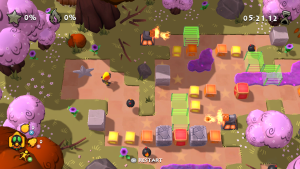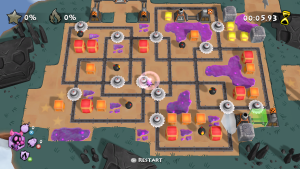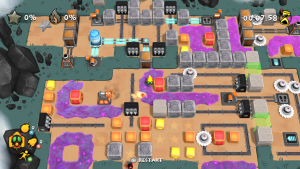If you took the basic concept behind Bomberman and tried to apply it to a puzzle game, you would probably get something somewhat like Burnstar. Though the focus here is upon collecting stars instead of killing enemies, you’ll be blowing up plenty of blocks with plus-shaped bomb explosions. That said, Burnstar is a game which does not hesitate to add in both plenty of new mechanics and enough significant changes to the Bomberman formula that the resemblance is ultimately largely superficial.
The most fundamental difference from Bomberman is almost certainly the fact that bombs are limited here. You start with no bombs at all and must collect individual bombs scattered throughout each stage. In addition to being limited, bombs also only ever affect the tile they are placed on and the four tiles around it so the gameplay is focused primarily upon placing bombs on the tiles where they will have the largest impact. It may not be possible to increase a bomb’s area of effect, but Burnstar is all about fiery chain reactions.
 The limited quantity of bombs in each stage firmly cements Burnstar in the action puzzle genre, but the fire mechanics are what make it unique. Destructible blocks exist, but the objects you’ll be primarily using bombs to interact with are crates and goo tiles. Purple goo tiles catch on fire when hit with an explosion and the fire will rapidly spread to adjacent goo tiles until nothing is left, often revealing collectible stars in the process. Crates also catch on fire from explosions, but are a bit more complicated as they come in three tiers. Crates range from red to orange to yellow, red crates are the largest while yellow crates are the smallest, and any crate which catches on fire will spread that fire to adjacent crates of the same size or smaller as well as to any nearby goo. However, orange crates will explode like a bomb after a few seconds, which allows them to set adjacent red crates on fire and destroy cracked blocks. Even more importantly, red crates also explode after a few seconds, but this explosion can travel up to two tiles in all four directions if it is not blocked by an indestructible object, allowing them to spread fire across gaps. On top of all of this, crates will also catch on fire if they are surrounded by fire on at least three sides, allowing even goo to affect red crates if there is enough of it. Though crates explode, they leave behind their burnt frames, so maximizing explosive chains is vital as a path cannot be cleared simply by affecting one or two crates.
The limited quantity of bombs in each stage firmly cements Burnstar in the action puzzle genre, but the fire mechanics are what make it unique. Destructible blocks exist, but the objects you’ll be primarily using bombs to interact with are crates and goo tiles. Purple goo tiles catch on fire when hit with an explosion and the fire will rapidly spread to adjacent goo tiles until nothing is left, often revealing collectible stars in the process. Crates also catch on fire from explosions, but are a bit more complicated as they come in three tiers. Crates range from red to orange to yellow, red crates are the largest while yellow crates are the smallest, and any crate which catches on fire will spread that fire to adjacent crates of the same size or smaller as well as to any nearby goo. However, orange crates will explode like a bomb after a few seconds, which allows them to set adjacent red crates on fire and destroy cracked blocks. Even more importantly, red crates also explode after a few seconds, but this explosion can travel up to two tiles in all four directions if it is not blocked by an indestructible object, allowing them to spread fire across gaps. On top of all of this, crates will also catch on fire if they are surrounded by fire on at least three sides, allowing even goo to affect red crates if there is enough of it. Though crates explode, they leave behind their burnt frames, so maximizing explosive chains is vital as a path cannot be cleared simply by affecting one or two crates.
Creating chain reactions with explosives may be the primary gameplay mechanic in Burnstar, but I haven’t gone too deeply into why you need to create these chains in the first place. Though explosions may indeed open up a path or uncover some sort of switch, the main reason to aim for big chains is to collect stars. Dozens of stars are embedded in the ground or hidden under goo in each stage and you must collect at least 70% of them and then actually make it to the exit in order to move on. Stars underneath goo tiles become collectible the moment the goo burns away while stars embedded in the ground will pop up once their tiles are hit by explosions. Though you do not need to destroy every single crate and goo tile to clear a stage, you definitely need to plan things out if you want to hit that 70% mark before you run out of resources. Of course, even though you don’t have to get every star, you can try to get an ‘all gold’ completion status for a stage by collecting every star, burning every single crate and goo tile, and making it to the exit under an often-strict par time all in a single run. Fully completing a stage can sometimes open up a path to an optional stage, which in turn may often lead to another optional stage or allow you to skip a few stages in a world, though the only real reward is usually a gold completion flag next to a stage instead of a green one so this is generally a task to undertake for the sake of the challenge in and of itself.

It is certainly worth mentioning that Burnstar has four playable characters, any of which can be chosen for any stage. Though the character designs have a great deal of personality put behind them, the characters themselves are not particularly interesting as their dialogue largely consists of backstory snippets and some occasional puns. Even if their characterization is not particularly interesting, each character has a unique ability which can significantly affect how you ultimately end up tackling a stage. Burnstar himself has a dash which slightly sacrifices control, but lets him more easily avoid hazards and makes him great in general for getting low times in stages. Ember cannot move while using her ability, but she will become completely invincible for as long as you hold down the button, making her potentially the best choice for completing stages if you don’t care about hitting the par time. Like Ember, Coldsnap’s ability is defensive in nature as she is able to send out a controllable ice orb which can freeze a single hazard at a time; Coldsnap’s ability is a neat concept, but I found myself using her less than anyone else and, judging by the leaderboards, I am far from the only one. Finally, Toxo definitely has the most interesting and versatile ability of the four as he is able to create a clone which can be used to hold down various switches and can be warped back to by holding down the ability buttons. The presence of these abilities really is a game-changer as they not only can radically alter the way you approach a stage, but they are evenly split to accommodate multiple playstyles; Burnstar and Toxo have abilities which are generally best for speedrunning stages and getting gold completions while Ember and Coldsnap have abilities which, while not impossible to hit par times with, prioritize survival over speed.

I have previously mentioned that the focus of Burnstar is not upon killing enemies, and stages with any enemies at all are indeed few and far between, but what Burnstar may lack in enemy variety it certainly makes up for in hazards and obstacles. Conveyor belts, multiple different types of switches, lasers which must be redirected via mirrors, and several other staples of the action puzzle genre are all present and accounted for. Hazards such as whirling saw blades, turrets, fire plates, and, of course, your own explosions and fires are quite plentiful and more than make up for the low enemy count; you can probably expect to die at least a few times in just about any of the later stages even without going for a perfect run. Even your weaponry is somewhat varied as you eventually gain access to rockets, which are similar to bombs, but they move in a straight line and immediately explode upon coming into contact with a crate or some other solid object. Most of these tools and hazards have appeared in plenty of other games, but they are nonetheless used well here and often interact with the fire mechanics in clever ways.
 Multiple little bits of polish across the board further aid Burnstar in becoming an excellent action puzzle game and boost it above a good chunk of the competition. The most noteworthy of these bits is by far the respawn speed. It takes a few seconds to load up a new stage, but the time it takes to respawn upon death is negligible and manually restarting takes nothing more than a single button press and is virtually instantaneous. Even restarting a stage as a different character is simply a matter of bringing up the menu and pressing down twice to reach the character select menu without needing to go back out to the main map. Considering how my attempts at getting a full clear on a stage often involved dozens of deaths and manual restarts, often within less than ten seconds of each other, having a fast respawn time was just as essential here as in something like Super Meat Boy and the developers over at Nerve Software definitely knew it. Leaderboards for both any percent completion and full completion are present for every stage, display which character each player used to obtain their time, and can be viewed both globally and filtered to show friends only. Finally, there are two handy featured tied to bombs. Since bombs are limited, you are allowed to pick up any bomb you’ve placed before it explodes and put it back into your inventory, which is handy if you need to time an explosion or if you placed a bomb on the wrong tile. An even nicer feature is the ability to press a button to show a targeting reticle indicating which tile your character will place a bomb on, which is more useful than it may sound as without this ability it can sometimes be difficult to tell if your character will be placing a bomb on the tile they are standing on or on top of an object on an adjacent tile.
Multiple little bits of polish across the board further aid Burnstar in becoming an excellent action puzzle game and boost it above a good chunk of the competition. The most noteworthy of these bits is by far the respawn speed. It takes a few seconds to load up a new stage, but the time it takes to respawn upon death is negligible and manually restarting takes nothing more than a single button press and is virtually instantaneous. Even restarting a stage as a different character is simply a matter of bringing up the menu and pressing down twice to reach the character select menu without needing to go back out to the main map. Considering how my attempts at getting a full clear on a stage often involved dozens of deaths and manual restarts, often within less than ten seconds of each other, having a fast respawn time was just as essential here as in something like Super Meat Boy and the developers over at Nerve Software definitely knew it. Leaderboards for both any percent completion and full completion are present for every stage, display which character each player used to obtain their time, and can be viewed both globally and filtered to show friends only. Finally, there are two handy featured tied to bombs. Since bombs are limited, you are allowed to pick up any bomb you’ve placed before it explodes and put it back into your inventory, which is handy if you need to time an explosion or if you placed a bomb on the wrong tile. An even nicer feature is the ability to press a button to show a targeting reticle indicating which tile your character will place a bomb on, which is more useful than it may sound as without this ability it can sometimes be difficult to tell if your character will be placing a bomb on the tile they are standing on or on top of an object on an adjacent tile.
I have always been a huge fan of this particular subgenre ever since I was first exposed to it with Adventures of Lolo all the way back on the NES and, with its ability to meld clever puzzles and unique fast-paced action together, Burnstar serves as a shining example of how much entertainment and diversity this subgenre has to offer.